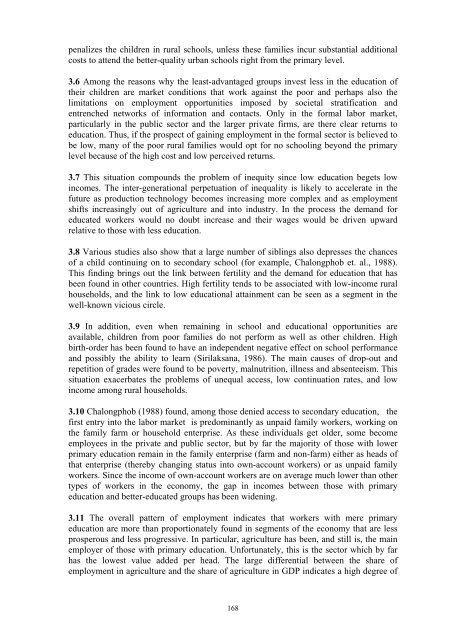Educational Finance in Thailand - UNESCO Bangkok
Educational Finance in Thailand - UNESCO Bangkok
Educational Finance in Thailand - UNESCO Bangkok
Create successful ePaper yourself
Turn your PDF publications into a flip-book with our unique Google optimized e-Paper software.
penalizes the children <strong>in</strong> rural schools, unless these families <strong>in</strong>cur substantial additional<br />
costs to attend the better-quality urban schools right from the primary level.<br />
3.6 Among the reasons why the least-advantaged groups <strong>in</strong>vest less <strong>in</strong> the education of<br />
their children are market conditions that work aga<strong>in</strong>st the poor and perhaps also the<br />
limitations on employment opportunities imposed by societal stratification and<br />
entrenched networks of <strong>in</strong>formation and contacts. Only <strong>in</strong> the formal labor market,<br />
particularly <strong>in</strong> the public sector and the larger private firms, are there clear returns to<br />
education. Thus, if the prospect of ga<strong>in</strong><strong>in</strong>g employment <strong>in</strong> the formal sector is believed to<br />
be low, many of the poor rural families would opt for no school<strong>in</strong>g beyond the primary<br />
level because of the high cost and low perceived returns.<br />
3.7 This situation compounds the problem of <strong>in</strong>equity s<strong>in</strong>ce low education begets low<br />
<strong>in</strong>comes. The <strong>in</strong>ter-generational perpetuation of <strong>in</strong>equality is likely to accelerate <strong>in</strong> the<br />
future as production technology becomes <strong>in</strong>creas<strong>in</strong>g more complex and as employment<br />
shifts <strong>in</strong>creas<strong>in</strong>gly out of agriculture and <strong>in</strong>to <strong>in</strong>dustry. In the process the demand for<br />
educated workers would no doubt <strong>in</strong>crease and their wages would be driven upward<br />
relative to those with less education.<br />
3.8 Various studies also show that a large number of sibl<strong>in</strong>gs also depresses the chances<br />
of a child cont<strong>in</strong>u<strong>in</strong>g on to secondary school (for example, Chalongphob et. al., 1988).<br />
This f<strong>in</strong>d<strong>in</strong>g br<strong>in</strong>gs out the l<strong>in</strong>k between fertility and the demand for education that has<br />
been found <strong>in</strong> other countries. High fertility tends to be associated with low-<strong>in</strong>come rural<br />
households, and the l<strong>in</strong>k to low educational atta<strong>in</strong>ment can be seen as a segment <strong>in</strong> the<br />
well-known vicious circle.<br />
3.9 In addition, even when rema<strong>in</strong><strong>in</strong>g <strong>in</strong> school and educational opportunities are<br />
available, children from poor families do not perform as well as other children. High<br />
birth-order has been found to have an <strong>in</strong>dependent negative effect on school performance<br />
and possibly the ability to learn (Sirilaksana, 1986). The ma<strong>in</strong> causes of drop-out and<br />
repetition of grades were found to be poverty, malnutrition, illness and absenteeism. This<br />
situation exacerbates the problems of unequal access, low cont<strong>in</strong>uation rates, and low<br />
<strong>in</strong>come among rural households.<br />
3.10 Chalongphob (1988) found, among those denied access to secondary education, the<br />
first entry <strong>in</strong>to the labor market is predom<strong>in</strong>antly as unpaid family workers, work<strong>in</strong>g on<br />
the family farm or household enterprise. As these <strong>in</strong>dividuals get older, some become<br />
employees <strong>in</strong> the private and public sector, but by far the majority of those with lower<br />
primary education rema<strong>in</strong> <strong>in</strong> the family enterprise (farm and non-farm) either as heads of<br />
that enterprise (thereby chang<strong>in</strong>g status <strong>in</strong>to own-account workers) or as unpaid family<br />
workers. S<strong>in</strong>ce the <strong>in</strong>come of own-account workers are on average much lower than other<br />
types of workers <strong>in</strong> the economy, the gap <strong>in</strong> <strong>in</strong>comes between those with primary<br />
education and better-educated groups has been widen<strong>in</strong>g.<br />
3.11 The overall pattern of employment <strong>in</strong>dicates that workers with mere primary<br />
education are more than proportionately found <strong>in</strong> segments of the economy that are less<br />
prosperous and less progressive. In particular, agriculture has been, and still is, the ma<strong>in</strong><br />
employer of those with primary education. Unfortunately, this is the sector which by far<br />
has the lowest value added per head. The large differential between the share of<br />
employment <strong>in</strong> agriculture and the share of agriculture <strong>in</strong> GDP <strong>in</strong>dicates a high degree of<br />
168

















